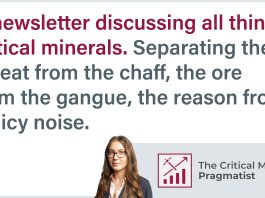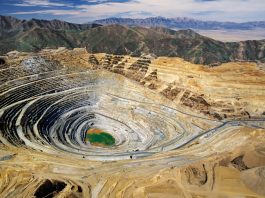Welcome to the latest edition of the Critical Minerals Pragmatist, written by Olimpia Pilch, a newsletter that provides you with a unique perspective on the global critical minerals landscape.
I increasingly find myself asking, “what next?”, and “where are we headed?” as the Western world. For all the talk, endless roundtables and waffle in the media, there has been very little change. Many OEMs are turning their back not only on Western miners but their home governments, democratic principles and values, in favour of competing in a Chinese-dominated market. The strategy appears to have shifted to “if you can’t beat them, join them” as more and more partnerships are being struck with Chinese competitors. We have seen this over and over throughout the past 20+ years, those who chose to go down that path will reap what they sow. The rise of globalisation eroded patriotism and with it strategic thinking. Many companies want to be like Glencore, unanchored and unattached to any particular nation, able to strike deals and throw nations under the bus in the name of profit. But most companies are not Glencore. And many more rely on some sort of government assistance in the form of subsidies or lenient treatment. Or their brands carry a rich history embedded or attached to a nation or how its people are perceived (e.g. German carmakers).
Western governments seem to put out press releases that ultimately mean very little since China’s hegemony still calls the shots. More and more miners and juniors call for government support, but subsidising projects with weak fundamentals is a fool’s errand and not sustainable over the long period. Many want to find the silver bullet and find the solution to fixing the problem. The issue I take with that is that the problem has been poorly defined. Ask your average critical minerals Chris (sorry random Chrises!) about the problem and you’ll like to get the following: China, pricing, geopolitics, risk, and energy. Those are manifestations of a much deeper problem – a lack of strong leadership in government and business.
Henry Ford made supply chain integration sexy. Anglo-Persian saw the benefits of selling oil to the British Navy supporting the Allies, not the Central Powers. Today, companies answer to shareholders who care little for the wider implications of companies’ decisions on national economies and society. So long as the annual report appears to have enough DEI and ESG fluff.
CEOs and Board members are rarely long-term fixtures able to carry out visions and strategies through decades. Career civil servants lack industry experience and the system is designed to avoid making any decisions, only to ride it out in-between promotion cycles. Leaders of Western countries leave a lot to be desired. The Starmers and Bidens of today are no Churchills or Lincolns.
Diversifying away from China is not a destination, it’s a process. What do diversified supply chains look like in practice? Is less than 40% controlled by China diverse enough, what about if another 10% is held by a geography that is dominated by Chinese companies? Or are we looking for less than 30, 20%, 10%? What about Russia? Which critical minerals are we talking about? Trying to do too much at once dilutes effective action.
Who will be the customer? Do all Westerners want to gobble up “green tech” or is it just the upper middle class? How do we drive demand without limiting consumer choice? Does the average Joe, Carlos, Ludwig, or Pierre want to give up access to cheaper Chinese alternatives?
One can only conclude that the blind are leading the blind and no one actually knows where they are headed.
Australia’s fledgling batteries downstream sector at a crossroads
Misleading headlines at their best. What battery sector? The article goes on to talk about mining and chemical processing…
Australia’s efforts to establish a downstream lithium sector were dealt another blow last week when Albemarle (NYSE: ALB) suspended parts of its Kemerton hydroxide plant, south of Perth.
Other market players have had their quota of challenges. Tianqi Lithium and IGO Ltd. (ASX: IGO) have struggled to ramp up their Kwinana hydroxide plant, in an industrial area outside Perth, since it was restarted in late 2021.
Boy, when even the Chinese are struggling…the times are truly hard…
“I think that’s going to remain really difficult in Australia. We simply don’t have the right cost structures,” he said. “We simply don’t have the right industry structures to really succeed and place our players well.”
Australia doesn’t have a market to tap into outside of China. To be able to ramp up or even sustain production in Australia there must first be demand and elevated prices. To drive down CAPEX and OPEX to numbers that are globally competitive, Australia would need to slash the costs of energy by shaving off some juicy tax, improve access to it, and convince its workers that slashing their wages by three quarters is good for them. Until such an unthinkable day occurs, Australia will become less and less attractive especially as more illegal lithium mining flows into China.
Vella said he wasn’t nervous about the prospect of IGO being blocked from receiving subsidies due from its Chinese partner.
The secret to successful operations: Chinese subsidies.
“What we’re trying to do is build Australian assets for Australia, Australian jobs, Australian supply chain, Australian industry that has strength and longevity,” he said.
“Where that capital comes from shouldn’t really be a big determinant of how the government might contribute towards it – that will be something they’ll work through.
If it’s destined for China, and under Chinese control, it can hardly be called an Australian supply chain or Australian industry. Where the capital may come from may not matter – unless of course there are governance issues – but it is the strings attached to that capital that matter. Chinese companies are hardly philanthropists. Just ask the mine workers across Africa.
“But fundamentally, we have to make the decisions based on a good business case and it has to be competitive on its own right, so if you really live and die on some subsidy, I think that’s a very dangerous place to be.”
Ironic. Is IGO still competitive without that Chinese subsidy it does not fear being blocked from receiving?
“We need a new port here in WA. We need power to be secure. We don’t need the cheapest power in the world, but we need reliable power where people can build 20-year projects and know that they’re going to have consistent power pricing,” he said.
Oh sweet summer child, while you may speak reason, ‘tis beyond the comprehension of mere career civil servants to hatch plans beyond promotion cycles, let alone decades.
Zambia closes border with Congo, blocking key copper trade route
Zambia has temporarily shut its borders with the Democratic Republic of Congo, the government said at the weekend, in a move that could delay exports from Africa’s biggest copper producer.
Most of Congo’s copper travels through Zambia to reach regional ports.
This will place pressure on the DRC and cause headaches for Chinese companies awaiting shipments of ore to refine. Rerouting would add significant time and cost.
For months the DRC has appeared to be treading an odd path. The lawsuit against Apple, despite DRC elites turning a blind eye to Chinese companies being the largest consumer of hand-dug ore, Gecamines lobbying on behalf of Gertler to get royalties, and imposing bans on Zambian imports…points towards the DRC trying to get rich and remain topical on the global stage. The erratic manoeuvres point towards increasing pressure and further destabilisation. One would not have to look too deep beneath the surface to find Africa Corp’s signatures all over.
On the flip side, DRC’s ban has given Zambia the perfect opportunity to temporarily cut off, or at least delay, its biggest competitor. Talk about making lemonade out of lemons. But, Zambia’s proposed mining law has recently come under criticism as unattractive to investors.
“Unfortunately, due to . . . the prospect of forced ‘free carry’ acquisitions by the State of stakes in new ventures, this Bill will seriously undermine property rights,” the mining industry bodies said.
“The Bill also grants unaccountable and arbitrary discretionary decision making powers to individual regulators, which present obvious future corruption risks,” they added.
Government shareholding and meddling are almost always looked down upon by Western investors, especially when the governments haven’t got a track record of behaving reputably.
India to offer incentives for critical minerals extraction, govt source says
India plans to provide funding for research institutes to give technical assistance to miners, according to a government source and a letter reviewed by Reuters, to try to develop a critical minerals industry.
So far, India’s attempts to create a critical minerals mining industry have faltered. The country awarded development rights in June to a lithium block in Chhattisgarh state but a separate attempt to auction lithium blocks in Jammu and Kashmir found no takers because of low mineral concentration and high extraction costs.
Governments seem to ignore the fundamentals of economics at every turn expecting companies to carry out charity work. While it is obvious that India wants to avoid sustained dependence on China for green tech and critical minerals, pushing for unfeasible operations will simply lead to taxpayers’ money being washed down the drain.
The government could spend nearly $50 million to fund collaborations between research institutes and companies to develop extraction technology and better methods of beneficiation, or the improvement of mineral ores before processing into metals, according to a government source involved in the matter.
The government will invite joint proposals from institutes and companies and those approved will get up to 75% of the total funding, said the government source, declining to be named as they were not authorised to talk to the media.
Innovation is key to competing with China on price. 100% behind developing new tech. But, we’re talking about India here…how much of that $50 m will disappear into the abyss? There’s also the reality that $50m does not stretch that far…









